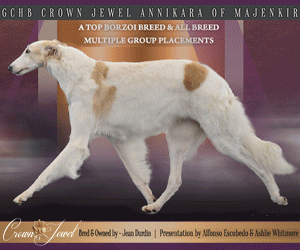When Did the Dog Become Man’s Best Friend?
Click here to read the complete article
The timeline of dog domestication has been an ongoing source of scientific debate forever
By Amy Fernandez
 DNA analysis has revolutionized many investigative procedures. But so far, the biggest consequence of this new scientific precision has been more controversy, starting in 1993 with Dr. Robert K. Wayne’s UC-Davis study. Rather like early canine evolution, that was way back in the dark ages of genetic research. Therefore, general skepticism greeted his team’s mitochondrial analysis of ancient dog genome sequences which dated the start of the dog/wolf split to 135,000 years ago.
DNA analysis has revolutionized many investigative procedures. But so far, the biggest consequence of this new scientific precision has been more controversy, starting in 1993 with Dr. Robert K. Wayne’s UC-Davis study. Rather like early canine evolution, that was way back in the dark ages of genetic research. Therefore, general skepticism greeted his team’s mitochondrial analysis of ancient dog genome sequences which dated the start of the dog/wolf split to 135,000 years ago.
A lot has happened since. The related technology has advanced significantly, making it much easier to extract and sequence DNA from fossils. Concurrently, plenty more have been discovered. Presumably, this concurrent informational treasure trove should guide the scientific community toward some answers; but we know better because in that universe, more discoveries equal more arguments.
So let’s get to the latest breakthrough reported May 21 in the journal Current Biology. It was the work of an international research team from the Swedish Museum of Natural History led by Pontus Skoglund from Harvard Medical School and the Broad Institute of Harvard and MIT. They have provided the newest piece in the canine evolutionary puzzle by sequencing nuclear and mitochondrial DNA from a bone fragment discovered on Siberia’s Taimyr Peninsula. Initially thought to be from a prehistoric reindeer, it turned out to be the first documented relic from an ancient wolf. Christened the Taimyr wolf, the team calculated that the species waltzed around the tundra 27,000-40,000 years ago.
Dated at 35,000 years old, this bone fragment doesn’t come close to the date reported by Wayne’s 1993 study, but it is clear evidence that early canids began their fateful detour to dogtown way back in the Pleistocene Era. It helps to reset the currently accepted timeline of canine evolution and adds a bit more weight to the theory that domestication was brewing much earlier than previously believed. More importantly, it paves the way for new avenues of archeological research in this field.
From a purebred perspective, genetic links between early canids and modern dogs is especially illuminating. DNA evidence had refuted the conventionally accepted histories of many breeds and also confirmed the genuinely ancient heritage of a few.
Subsequent investigations of this little tundra treasure have identified the Taimyr wolf as an ancestor of two breeds indigenous to that region, the Greenland Dog and the Siberian Husky.
We’ve learned a lot, especially when you consider that research on canine evolution is a very recent development. Although archeology has been a serious pursuit for centuries, dog fossils were rarely collected or studied. The scientific community didn’t latch onto their value until they realized the link between canine and human evolution. And when they started looking for dog relics, they were everyplace! That was the first of many surprises connected to this deal.
Long before DNA analysis became a factor in the equation, evidence suggested the divergence between Canis lupus and Canis familiaris was a long strange trip. Wolves split off from their coyote/jackal ancestors within the last million years. Relatively speaking, that makes them a recent species. And from that standpoint, dogs are simply an afterthought. Debate continues as to whether dogs qualify as a distinct species or merely a wolf subspecies.
Over the next half-million years or so, wolves evolved in Arctic Eurasia. Approximately 100,000 years ago global warming signaled the first game changer. Melting glacial barriers provided their intercontinental gateway to stake claims in Europe, Asia, and North America. At that point, wolves possessed two critical advantages: an innate drive to explore, and adaptability to flourish in different environments. Thanks to those traits, they really gained traction during the last Ice Age. This newly frigid environment was the curtain call for most large mammals. Canis lupus was more than a survivor. When the smoke cleared it was the most widely distributed large carnivore, ruling the food chain. Meanwhile, our ancestors moved out of Africa and pretty much the same biological imperative guided their strategy.
Up to this point, the story seems pretty straightforward. The last Ice Age is considered the conventional start of the canine/human relationship, but from an evolutionary standpoint it’s more like the final act in a long, complicated drama. Yes, humans and wolves are highly intelligent, adaptable, social species. Those similarities certainly factored into this alliance, but realistically nothing suggested that the human/wolf interspecies collision was a preordained perfect match or even a possibility.
Here are a few loose ends to consider
In nature, interspecies competition is far more common than interspecies cooperation. For instance, wolves didn’t team up with grizzlies or big cats although those odd couple arrangements could have been equally beneficial to survival.
Separation is the rule for competitive predators sharing territory. Eventually, one gains a slight advantage and the loser gets an eviction notice via local extinction or downgrading to another ecological niche. And nothing in the evolutionary playbook matched the trump card of human encroachment. Wolves retain their global presence mostly because they are a protected species in most places. Over time, humans got the upper hand, but as a rule, those interspecies standoffs never ended well.
Theoretically, domestication was the compromise that offered wolves a better deal. A range of factors can trigger divergence within a species, but they almost never lead to domestication, which can be induced by controlled breeding or environmental adaptation. Neither one really explains how this happened. We’re all familiar with the scenarios featured in science books. Cave dwelling humans hunkered down around a fire, tossing an occasional mastodon bone to the forlorn hungry wolves watching enviously from the sidelines. Really? At that stage of the game, it’s likely that hungry humans were scrounging for a handout just as often. From there, history tells us that the dog became the prototype for the domestication of other species.
From a dog breeder’s perspective, there are some sinkhole-sized gaps in that theory. It is hard to understand how or why a carnivorous predator became the first candidate in this hypothetical grand plan to subjugate other species. For one thing, sheep, goats, pigs, and chickens have nothing in common with wolves. Never mind their social/behavioral differences. Carnivore/herbivore? That alone makes it hard to understand the rationale prompting the leap of insight that led from domesticating wolves to choosing the next candidate from species at the other end of spectrum.
By the most conservative reckoning, thousands of years elapsed before the next big development in the domestication notebook. Once it got underway, livestock domestication gained traction very quickly between 8000-2500 BC beginning with sheep, goats, and pigs. Those successes were accompanied by plenty of failed attempts to domesticate other species. It’s also easier to trace the progression of these breakthrough developments to specific events in well-established human population centers. From there, the technology was subsequently transmitted to other civilizations. The cat, the only other domesticated carnivore, didn’t join the ranks until thousands of years later, but its evolution is also traceable to a precise area of southwest Asia. In contrast, nothing suggests that the wolf/dog changeover was premeditated, purposeful, or potentially useful. The process was more comparable to the federal government in action. It operated on a massive scale with incredible slowness and very little logical advancement.
Until quite recently, calculating milestones of canine evolution has been based on visual interpretation of skeletal traits signifying the wolf-to-dog transformation. Those determinations focus on a few anatomical details – changes in skull shape, skull-to-muzzle ratio, jaw size, dental size and positioning and overall size and proportion.
The first problem is these calculations work best with relatively intact specimens. Needless to say, scattered bits and pieces are the rule in this business. The bigger problem is physical changes regarded as the hallmarks of domestication have been found in every gradation dating back almost 40,000 years. Those key morphological changes tend to be especially ambiguous during the early stages of divergence. Even so, they provide evidence of five or six disparate founding canine populations in widely varying locations.
Evidence of domestication dating from 9000 years ago is more identifiable. Dogs left their footprint at archeological sites in Southwest Asia, China, and North America by 10,000 BC, the Mediterranean and Indian subcontinent by 6500 BC, Egypt by 6000 BC, Central Europe by 5400 BC, the Iberian Peninsula by 5200 BC, and Britain by 3500 BC.
After that, it gets tricky again. Ancient canines start exhibiting their broad spectrum of genetic plasticity. Size, proportion, leg length, skull and muzzle shape and length began to display notable variations long before selective breeding came into play. On top of that, ongoing dog/wolf hybridization maintained the interspecies interplay long after domestication. Canis familiaris can interbreed to produce fertile offspring with seven potential bedfellows within its genus. It happens most frequently with wolves and coyotes, and it’s gone on for thousands of years.
Then, 14,000 years ago another implausible twist began compounding these archeological conundrums. Ritual burial sites around the world confirm that the dog/human bond became more than a working relationship. At that point in human history, life was all about foraging, hunting, and maintaining a grip on survival. In that context, there’s no logical explanation for sharing scanty resources or donating energy to dig and decorate fancy dog graves. But the evidence is there, all over the planet. Considering all these baffling complications, the problem starts looking like a Poodle coat that hasn’t seen a brush in three months.
It’s hard to overlook the 100,000 year gap separating the estimates of forensic archeologists and molecular biologists. However, there’s no shortage of potential evidence that might resolve that mystery. But until now, much of it has been disputed or disregarded because it is visually ambiguous or simply unexplainable. In the past decade, genome sequencing has gone from the realm of science fiction to mainstream life, but it’s never been tried for this research before. From that perspective, the Taimyr wolf may be the tip of the iceberg. Similar genome reconstruction of other canine artifacts just might nail down this evolutionary enigma. You might say, what does it matter, dogs are here to stay. Still, it would be nice to know how that perennial canine roommate landed on the living room couch.
This megamerger between two predatory rivals at the top of the food chain was improbable. Those encounters bounced back and forth between rivalry and cooperation for at least 40,000 and possibly over 100,000 years, and more than once, that energy triggered the big split.
That implausible arrangement revised every aspect of life on this planet in ways that are so entrenched we don’t even see them. We are a long way from understanding the magnitude of this interspecies bond. However, domestication involves profound changes in body chemistry and sensory perception. From that perspective, it is counterintuitive to think that it was a one-way street. This co-evolutionary vibe left an indelible mark on both species. From my perspective, that knowledge is truly the holy grail of canine evolution research.
Short URL: http://caninechronicle.com/?p=86156
Comments are closed











